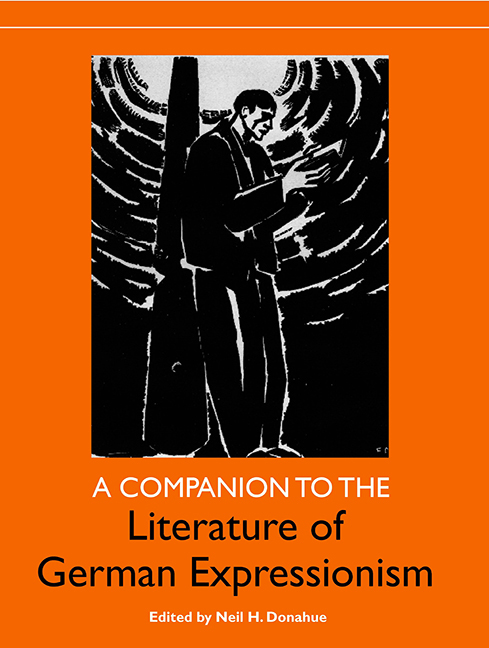Book contents
- Frontmatter
- Contents
- List of Illustrations
- Preface and Acknowledgments
- Chronology
- Introduction
- Philosophical Background
- Prose
- 2 The Prose of German Expressionism
- 3 Prosaic Intensities: The Short Prose of German Expressionism
- 4 The Cutting Edge of German Expressionism: The Woodcut Novel of Frans Masereel and Its Influences
- Poetry
- Drama
- Interdisciplinary
- Select Bibliography
- Notes on the Contributors
- Index
4 - The Cutting Edge of German Expressionism: The Woodcut Novel of Frans Masereel and Its Influences
from Prose
Published online by Cambridge University Press: 28 April 2017
- Frontmatter
- Contents
- List of Illustrations
- Preface and Acknowledgments
- Chronology
- Introduction
- Philosophical Background
- Prose
- 2 The Prose of German Expressionism
- 3 Prosaic Intensities: The Short Prose of German Expressionism
- 4 The Cutting Edge of German Expressionism: The Woodcut Novel of Frans Masereel and Its Influences
- Poetry
- Drama
- Interdisciplinary
- Select Bibliography
- Notes on the Contributors
- Index
Summary
In the early twentieth century, several artists in Europe and the United States developed a unique Expressionist aesthetic in the graphic arts while exploring Aufbruch (departure, break-up, revolution) and revolt, in a genre they named the “novel in woodcuts.” These works consist of a series of illustrations, sometimes numbering over one hundred, that narrate a story without any words at all. The idea of telling a story using only pictures is a simple one and common to children's picture books, but these woodcut novels are complex and moving, using only woodcuts, wood engravings, lithographs, or other forms of graphic art. They were published in book format with bound pages and a cover, usually the same size as novels, and drew on several artistic and political currents of the early twentieth century, particularly Expressionism. In the late twentieth century, these works continue to influence comic books, graphic novels, and the work of Art Spiegelman and other contemporary graphic artists. The genre's aesthetic explores the importance of language in both the expression and control of subversive ideas, and is expressionistic in theme and style. The irony at the center of these narratives lies in their exploration, entirely without words, of the power of language and the language of power.
The originator of the woodcut novel was Frans Masereel, the Belgian graphic artist. Before the First World War, Masereel illustrated editions of works by such Belgian writers as Emile Verhaeren, Pierre Jean Jouve, and Charles-Louis Phillipe and made a reputation as a highly skilled woodcut artist. He opposed the war and avoided active duty by serving as a translator for the Red Cross in Geneva, where he befriended other pacifists such as writers Romain Rolland and Stefan Zweig. Together they worked on pacifist journals such as La feuille and Les tablettes. Masereel provided crude, satiric woodcuts for these journals, and in them he would typically juxtapose the pronouncement of a politician or industrialist with a scene of battlefield carnage, and in doing so showed the vast gulf between the official rhetoric of the war and the reality.
- Type
- Chapter
- Information
- A Companion to the Literature of German Expressionism , pp. 111 - 134Publisher: Boydell & BrewerPrint publication year: 2005



